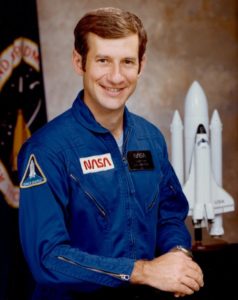
NASA launched a rocket that could be seen from the Lehigh Valley region on Wednesday, April 17, 2019, at NASA’s Wallops Flight Facility in Virginia. Terry Hart was a former NASA astronaut and is a mechanical engineering and mechanics professor at Lehigh. (Courtesy of Terry Hart)
NASA launched a rocket as part of a resupply mission to restock astronauts on the International Space Station with technological resources and nutrients on April 17. The launch took place at NASA’s Wallops Flight Facility in Virginia and was visible to some states along the East Coast.
Locally, cloud cover and unfavorable weather apparently shielded Lehigh Valley residents’ view of the launch, but the Antares rocket successfully lifted off at 4:46 p.m.
“It’s important to recall that we are in a cycle of ongoing missions and biological experiments, rather than one of the explorations,” said Terry Hart, former NASA astronaut and mechanical engineering and mechanics professor at Lehigh. “Some astronauts have been on the International Space Station since the year 2000. It’s important that they are fed and are given technology with which to continue researching.”
Hart said resupply missions are important not just because they bring astronauts materials to continue their experiments, but they are imperative to record the data of these experiments.
He said while these resupply missions bring back waste from the International Space Station, their value lies in the results that are brought to Earth for further examination in labs.
One aspect of this particular mission that was unlike previous resupply trips was that it made use of a new late load capability. By changing how the cargo was loaded prior to launch and by upgrading the technology that was used to do so, the cargo was able to be brought onboard the shuttle much closer to launch.
“I think that this was the most important part of this mission,” said Richard Hanes, a graduate student studying physics at Lehigh. “Because this new technology allows for the cargo to be loaded onto a shuttle about 24 hours before a launch, as opposed to almost four days as it was before.”
This mission also marked the inaugural launch of the Virginia Space ThinSat Program, a collaborative effort to educate students while still collecting data for further research.
While in orbit, the shuttle released 63 ThinSats, or thin satellites, which were built by students at certain schools such as the University of Illinois and Purdue University. Up until five days after the launch, students were able to collect data transmitted from their own satellites before they burned up in the atmosphere.
Some Lehigh students were intrigued by the recent mission.
“After the first photo of a black hole was released earlier this month, I became fascinated with the groundbreaking research done by astronauts,” said Ashley Haber, ‘21. “I can’t wait to hear about the results from this next round of research.”
The launch is prompting an increase in curiosity and interest in aerospace research from professors and students alike back down on Earth at Lehigh’s campus.





Comment policy
Comments posted to The Brown and White website are reviewed by a moderator before being approved. Incendiary speech or harassing language, including comments targeted at individuals, may be deemed unacceptable and not published. Spam and other soliciting will also be declined.
The Brown and White also reserves the right to not publish entirely anonymous comments.